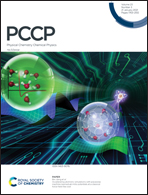Reactivity of dicationic N-heterocyclic chalcogen carbene analogues with methane and ethene: a theoretical investigation†
Abstract
The reactions of chalcogen N-heterocyclic carbenic (NHC) dications [(Dipp2DAB)M2+, M = O, S, Se, and Te, and Dipp2DAB = 1,4-(2,6-diisopropyl)phenyl-1,4-diaza-1,3-butadiene] with methane and ethene are investigated by the density functional theory. The activation energies and reaction enthalpies are analyzed by the energy decomposition analysis (EDA) to understand the reactivity of the reactions. Calculations show that the oxide carbenic dication (Dipp2DAB)O2+ reactant has a pair of rather unbalanced O–N bonds due to the combined effects of the smallness of the central O atom and the bulkiness of the two Dipp ligands surrounding the DAB ring, suggesting the oxide reactant is much less stable than the chalcogenide ones. Because of its unique characteristics, the oxide carbenic dication distinguishes itself from the rest of the chalcogen family. The differences between oxides and chalcogenides of the chalcogen family complexes well known in inorganic chemistry are also observed in this theoretical investigation. This work further reveals that the reasons for the distinctive characteristics between oxide and chalcogenide complexes are due to the fundamental fact that the 2s and 2p atomic orbitals are more amenable to hybridization than those of higher valences, and the mixing of the former valence orbitals results in much smaller atoms than the latter.



 Please wait while we load your content...
Please wait while we load your content...